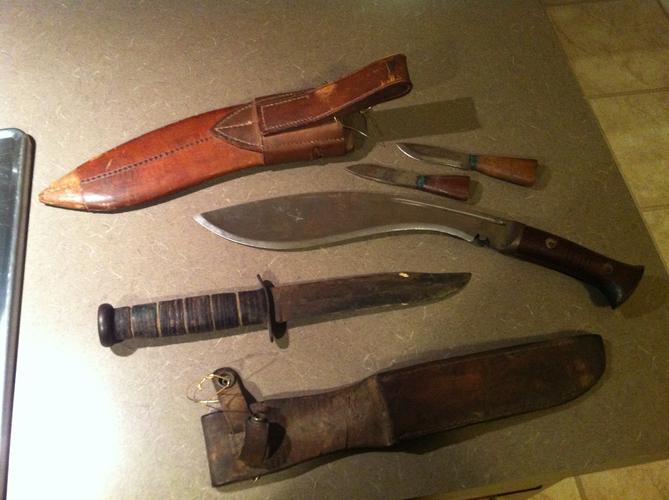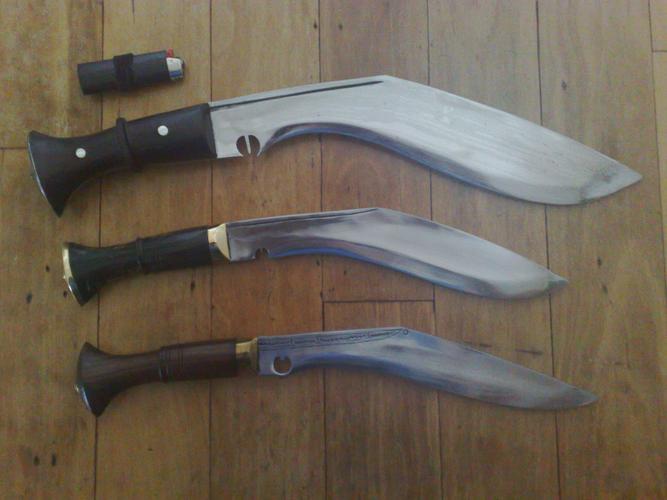Results 1 to 10 of 44
Thread: Two knives
-
12-13-2012, 12:05 AM #1Senior Member


- Join Date
- Nov 2010
- Location
- Pequea, Pennsylvania
- Posts
- 2,290
Thanked: 375 Two knives
Two knives
Thought I'd share this and hopefully someone can give me some information on at least the one knife. I was at my dad's this evening and he gave me these two knives. The one is from India I believe and the other was hand made. My Grandfather was in in World war ll and brought the Kurki (not sure about the name) and I was told it was used to decapitate. It has two smaller pieces with it, one to dig bullets out and the other was used to sharpen it. My great Grandmother, my Dad said didn't like it in her house because she knew two much about this knife, apparently there are stories with this one. The other my grandfather made from a file. my dad also has a Japanese sword and a German dagger from the war, that I may inherit one day. neat pieces of history.

-
12-13-2012, 12:21 AM #2

Dang that's cool! Sorry I can't help... but I just wanted to express my enthusiasm.
 David
David
-
12-13-2012, 12:55 AM #3Senior Member



- Join Date
- Mar 2012
- Location
- Thunder Bay, Ontario, Canada
- Posts
- 17,393
Thanked: 3228
This might get you started on the one knife Kukri - Wikipedia, the free encyclopedia.
BobLife is a terminal illness in the end
-
The Following User Says Thank You to BobH For This Useful Post:
Trimmy72 (12-13-2012)
-
12-13-2012, 01:18 AM #4May your bone always be well buried




- Join Date
- Jun 2010
- Location
- Brisbane/Redcliffe, Australia
- Posts
- 6,380
Thanked: 983
The Khukuri is just a general purpose everyday knife in Nepal. It's used from food prep to clearing a patch of ground ready for planting. The two small 'knives'; One is a small knife used for anything you want a small knife for and the other will be blunt all around the edge is used like a steel for maintaining the edge of your knife, but not actually sharpening unless you have bt of time to kill. The steel on the 'sharpener' is harder than the steel of the Khukuri blade.
During WWI and WWII (and a few other lesser known wars) The Gurkha's made for a fearsome warrior and used the Khukuri to great effect as a close combat weapon. The edge is a continuous curve which gives it it's great cutting power. However, to use it well in that fashion, still takes practice and a keen edge.
The Khukuri from pre-WWI to just after WWI is a much heavier weapon than those of later conflicts, and make todays Khukuri carried by the modern Gurkha look and feel like a pocketknife in comparison.
Khukuri come in quite a few variants these days, but have always had style variations depending on the region of Nepal that they were made in. Another link that might be of interest to you is this one here: Khukuri House - Official Khukuri/Kukri supplier to Gurkhas
Hope this is of some use to you.
MickLast edited by MickR; 12-13-2012 at 01:21 AM.
-
The Following 3 Users Say Thank You to MickR For This Useful Post:
Hirlau (12-13-2012), ScottGoodman (12-19-2012), Trimmy72 (12-13-2012)
-
12-13-2012, 01:37 AM #5Senior Member


- Join Date
- Nov 2010
- Location
- Pequea, Pennsylvania
- Posts
- 2,290
Thanked: 375
Thanks for all the resources for info.
I found out it doesn't have any marking's. I know it's from at least the 40's and it's a substantial piece of steel! the length of this entire thing runs from my elbow (blade tip) to my hand, and weighs 1 lb., the blade alone is around 11" long not including the handle.
-
12-13-2012, 01:44 AM #6May your bone always be well buried




- Join Date
- Jun 2010
- Location
- Brisbane/Redcliffe, Australia
- Posts
- 6,380
Thanked: 983
Here are three of mine; The top one is a WWI model, Middle is the model carried by todays Gurkha and the bottom one is just a general knife that you would find in use in a kitchen or a field. Mainly an Eastern Nepalese design. A farmers knife.
You'll notice that not all Khukuri came with the small 'knives'. These were a newer addition, and in my opinion, a practical one. The Bic lighter is there for scale.

Mick
-
The Following User Says Thank You to MickR For This Useful Post:
Trimmy72 (12-13-2012)
-
12-13-2012, 01:46 AM #7
-
12-13-2012, 02:20 AM #8Thread derailment specialist.



- Join Date
- Dec 2011
- Location
- Republica de Tejas
- Posts
- 2,792
Thanked: 884
Another note on the Khukuri. When used as a weapon, the Ghurkas used a back hand swing. That is, if you are right handed, you start the swing high on your left and come downward and across rather than using it machete style.
The bottom knife you have pictured looks remarkably like a MKII fighting knife or perhaps a PAL RH37 or maybe an RH36


Look closely in front of the guard on that knife and you will more than likely see some stamping that will tell you who made the knife.
This is an unissued Khukri with MOD (Ministry of Defense) "broad arrow" (resembles a chicken track) stamp on it.


Yours are great knives and with a family history, that's even better. Member Tonkin Gulf Yacht Club, participant SE Asia War Games 1972-1973. The oath I swore has no statute of limitation.
Member Tonkin Gulf Yacht Club, participant SE Asia War Games 1972-1973. The oath I swore has no statute of limitation.
-
The Following User Says Thank You to Wullie For This Useful Post:
Trimmy72 (12-13-2012)
-
12-13-2012, 02:23 AM #9"My words are of iron..."


- Join Date
- Oct 2006
- Posts
- 1,898
Thanked: 995
Wullie beat me to it.
If the second knife you refer to is the bottom one, that's got all the form of a classic Ka-Bar. Common issue for US Navy and other military personnel. This is not to say it could not be hand made, its a very good copy of a factory production knife meaning why go to the bother when you could buy one.
-
12-13-2012, 03:10 AM #10Senior Member


- Join Date
- Nov 2010
- Location
- Pequea, Pennsylvania
- Posts
- 2,290
Thanked: 375
Yes it does look very similar, I see no markings on it though. It has some rust that may be hiding the marking's. When I get some time I'll clean it up, I might see something then. The handles look identical.....


 36Likes
36Likes LinkBack URL
LinkBack URL About LinkBacks
About LinkBacks






 Reply With Quote
Reply With Quote
